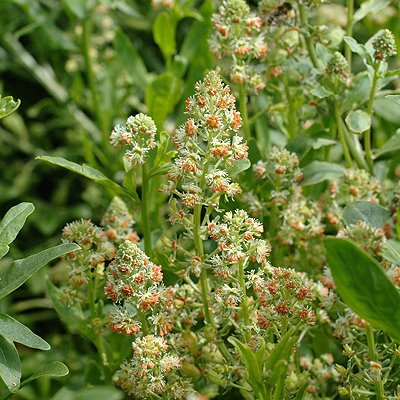 |
| Mignonette, picture from Select Seeds |
“Soon the rumor of its fragrance carried it across the Channel to London where it was so much used in window boxes that a writer of the time said, “We have frequently found the perfume of of Mignonette so powerful in some of the better streets that we have considered it sufficient to protect the inhabitants from those effluvia which bring disorders with them in the air.” ~ The Fragrant Path: A Book About Sweet Scented Flowers and Leaves by Louise Beebe Wilder (New York: The Macmillan Company, 1932)
I’ve spent an evening, more or less, exploring the world of Mignonette, Reseda odorata.
The end of the story is that I ordered seeds for Mignonette, and a few other scented flowers, from Select Seeds. I decided to set aside one of the planting beds in the Vegetable Garden Cathedral for a cutting garden which will include several annuals known for their fragrance, including Mignonette.
As best I can tell, Mignonette will be a weedy, not overly attractive flower, growing to about 18 inches, but it will be sweetly scented, almost like raspberries.
I checked my copy of The Annuals of Flowerland by Alice T. A. Quackenbush (New York: The Macmillan Company, 1927) to see what Quackenbush wrote about this particular annual flower.
She noted that Mignonette “likes rich soil and does not take kindly to transplanting”. She also recommended not dis-budding it to increase the size of the bloom and suggested the variety ‘Machet’ for “all-around excellence, and you cannot go wrong”.
I took as a sign that I should buy the seeds when I found that Select Seeds has the variety ‘Machet‘. Hopefully, eight or so weeks after direct sowing it in the spring, Mignonette will bloom in my garden and I can smell it for myself. I can also use it to protect myself from effluvia, which fortunately for me isn’t as prevalent around my garden as it apparently was around the streets of London at the turn of the 20th century.
When I finally smell the blooms, I’ll also think of good deeds and the story of how this flower got its name, Mignonette. To quote Quackenbush…
“The Mignonette is associated with the story of a mortal maid. This young girl was not beautiful; quite the contrary, and spent most of her time in tears over the lamentable fact. One day she was visited by a fairy, disguised as an old woman, who offered her the gift of beauty if she would promise to obey her orders for one year. No lifting of the face, no cosmetics, were suggested by this wise old beauty specialist; merely to do a good deed each day and never look in a mirror. When the fairy vanished, as a reminder to the maiden of her promise she left a plant in a vase. The flower of this plant was inconspicuous, but as fragrant as a good deed, and when the maiden saw it she cried, “You little darling (Mignonette)!” Lest any one doubt the efficacy of this cure for ugliness, the story ends by telling how when the year was out the good fairy returned and held a mirror before the face which had formerly been unlovely– and lo, the expression of discontent had completely disappeared and a gentle sweetness, like that of the Mignonette, had taken its place.”
Please note that the fairy disguised as an old woman in the story of Mignonette is no relation that I know of to the old woman at the door who sometimes visits me in my garden. Though I think my old woman would approve of doing good deeds each day, and of growing an unattractive flower for its fragrance.


I have often considered growing Mignonette for its fragrance but have never gotten around to it. I look forward to a full report when it blooms.
What an enchanting post, Carol. Your old gardening books are full of wisdom, indeed. I am glad to report there is little effluvia here anymore, or is there? Must find mignonette seeds.
Frances
Let's all grow mignonette this year and compare our experiences. Entertaining and informative, Carol.
Thank you for the wonderful post on Mignonette. I completely passed it by in my Select Seed catalog, but after reading your post I may have to get some seeds.
A sweet post about a sweet smelling flower…. I so enjoyed the story of the maiden and the Old Woman. One of the best 'moral' tales I ever hear.
I'd never heard of Mignonette until this week. Someone mentioned its 'insignificant flower and sweet, heavenly fragrance' in a fb gardening group and now your lovely post. I've learned something this week and that's a good thing.
Oh shoot. Now I want Mignonette too. I want to smell it.~~Dee
I wish you better luck with your mignonette than I've experienced. And I'm sure you'll have it! Looking forward to the nose news.
In the first influential language of flowers, created in 1819 by Louise Cortambert, under the pen name Charlotte de Latour, Mignonette means "your qualities surpass your charms," not a very encouraging message for a young woman to receive. The language of flowers as created by Latour was the language of the love affair, meant for a man to address a woman.
I have never smelled mignonette, but would like to. Perhaps I too w
ill order it and it can be my "longshot" of year.
Beverly Seaton